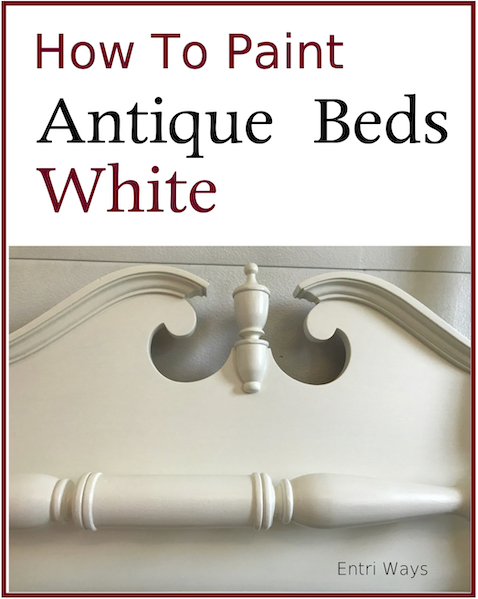Have you ever picked up a pair of antique beds from a yard or CraigsList with the intention of painting them a shade of white. The good news is that antique beds are solid wood. The problem, however, is how do you clean, prep and paint those antique beds white so they’ll last another 60 years. Here’s how…

This pair of twin beds belongs to a friend of mine. She purchased them from CraigsList for her daughter’s bedroom. The beds are believed to be more than 60 years old and had the wear & tear to suggest that age. Yet, underneath all of that, they are beautifully-made solid wood beds.
My friend had a dresser and desk in her daughter’s room that she painted with Annie Sloan’s Old White Chalk Paint several years ago. Unfortunately, there’s not an Annie Sloan paint supplier nearby anymore, but lucky for me there is a General Finishes paint supplier just down the street and their Antique White Milk Paint seemed to be a perfect match.
See how these antique beds were refinished in white…
Preparing Antique Furniture for Paint

The first step in preparing these antique beds for paint is a good exfoliation and cleaning. Take them outside, put on your P100 Vapor Mask and eye protection googles, and start sanding them down with your DeWalt rotary sander with a 60-grit sanding disc.
I remove as much of the dirt and clear topcoat as possible with the sander and then hand sand with sheets of 60-grit sandpaper. It’s back-breaking work. These two twin beds (headboards, footboard, and side rails) took about 3-4 hours to sand.
Remove most of sanding dust with a leaf blower. Then wipe the furniture down with a damp cloth to remove the remaining dust.
Once I’ve exfoliated the wood, I clean it with a degreasing solution like TSP. Alot of older furniture is covered in furniture wax. Furniture wax can be finishing wax or Pledge spray wax bulid-up. Either way, this has to be removed prior to painting. If you don’t, the paint will crackle.

Prime
Most paints these days are paint & primer products in one. So I wouldn’t need to apply a primer if I were painting a dark color. The customer, in this case however, wanted the beds painted in a warm antique white, which means a primer is absolutely necessary to prevent bleed-through of the old stain and topcoat (even if you think you removed it all). Trust me on this one.
There are three different types of primer. The regular water-based and oil-based primers which use only when I need to ensure extra adhesion of a paint. And then there’s BIN shellac-based primer. BIN is the only type of primer that actually blocks bleed-through of old stains and oil-based topcoats.
BIN is very smelly so it’s important that you work in an area with a ton of ventilation. I only use BIN when I can open the garage doors in my workshop. It’s best if you wear the P100 rated vapor mask too. This is also why there’s always an up-charge when painting furniture white.
A few tips when apply the BIN primer… It’s very thin and will spatter so move everything else out of the area or cover it. It’s very thin and dries very quickly so pour just a small amount into a separate container (never work from the can) and work quickly. Use an inexpensive 1-1/2 inch synthetic brush that you can throw away when you’re finished. I use THESE brushes from the Dollar Store.
The BIN primer dries almost instantly but I always wait until the next day to paint to ensure maximum adhesion.
Paint

Now, finally, the fun part! The beds were painted in General Finishes Antique White Milk Paint. I love milk paint. It goes on incredibly smooth (not thick or dry like chalk paint) and levels itself out really well.
It’s not necessary, but I do water milk paint down with just a small amount of water. This helps the paint spread a little easier, go on thinner, and reduce brush marks.
Even with the BIN stain-blocking primer, these beds still required 3 coats of paint. Going from a darker stain to a white usually does.

Topcoat

My friend plans to distress these just a bit along the edges to match a dresser and desk she painted a few years ago so I didn’t want a real heavy satin topcoat. Instead, for just the right amount of protection without the gloss, I applied Minwax Matte Polycrylic.
More than 12 hours and $80 in supplies later, these twin beds are now like new.





Leave a Reply